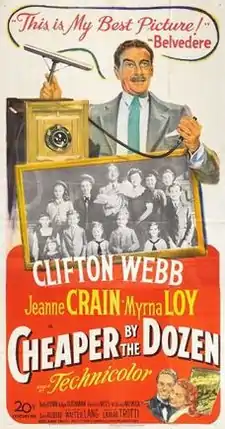Cheaper by the Dozen (1950 film)
Cheaper by the Dozen is a 1950 American family comedy film based upon the autobiographical book Cheaper by the Dozen (1948) by Frank Bunker Gilbreth Jr. and Ernestine Gilbreth Carey. The film and book describe growing up in a family with twelve children, in Montclair, New Jersey. The title comes from one of Gilbreth's favorite jokes, which played out in the movie, that when he and his family were out driving and stopped at a red light, a pedestrian would ask: "Hey, Mister! How come you got so many kids?" Gilbreth would pretend to ponder the question carefully, and then, just as the light turned green, would say: "Well, they come cheaper by the dozen, you know", and drive off.
| Cheaper by the Dozen | |
|---|---|
 Theatrical release poster | |
| Directed by | Walter Lang |
| Produced by | Lamar Trotti |
| Screenplay by | Lamar Trotti |
| Based on | Cheaper by the Dozen 1948 novel by Ernestine Gilbreth Carey Frank Bunker Gilbreth Jr. |
| Starring | Clifton Webb Myrna Loy Jeanne Crain Betty Lynn |
| Narrated by | Jeanne Crain |
| Music by | Cyril J. Mockridge |
| Cinematography | Leon Shamroy |
| Edited by | James Watson Webb Jr. |
| Distributed by | 20th Century Fox |
Release date | March 31, 1950 (New York)[1] |
Running time | 85 min. |
| Country | United States |
| Language | English |
| Budget | $1.7 million[2] |
| Box office | $4.425 million[3][4] |
Plot
The parents are the time and motion study and efficiency experts Frank Bunker Gilbreth Sr. and psychologist Lillian Moller Gilbreth. The film shows typical days in the lives of a family in the 1920s, but here with 12 children and an efficiency engineer as the parent. Frank employs his unorthodox teaching methods on his children, and there are clashes between parents and children. Frank takes every opportunity to study motion and increase efficiency, including filming his children's tonsillectomies to see if there are ways to streamline the operation.
After Frank's sudden death, the family agree that Lillian will continue with her husband's work; this enables the family to remain in their house, rather than move to their grandmother's in California, although, with a widowed working mother and one income, the children will have to assume much greater responsibilities.
Cast
- Clifton Webb as Frank Bunker Gilbreth Sr. (father)
- Myrna Loy as Mrs. Lillian Gilbreth (mother)
- Jeanne Crain as Ann Gilbreth
- Barbara Bates as Ernestine Gilbreth
- Betty Barker as Mary Gilbreth
- Patti Brady as Martha Gilbreth
- Norman Ollestad as Frank Gilbreth Jr.
- Carol Nugent as Lillie Gilbreth
- Jimmy Hunt as William Gilbreth
- Anthony Sydes as Fred Gilbreth
- Teddy Driver as Dan Gilbreth
- Roddy McCaskill as Jack Gilbreth
- Walter Baldwin as Jim Bracken
- Sara Allgood as Mrs. Monahan
- Evelyn Varden as School Principal
- Edgar Buchanan as Dr. Burton
- Mildred Natwick as Mrs. Mebane
- Craig Hill as Tom
- Betty Lynn as Deborah Lancaster
Comparison to real life
The birth order in which Cheaper by the Dozen portrays some of the children is not the same order in which the real Gilbreth children were born. For example, Robert (who was born in 1920) is shown as being born in 1922, as the last child after Jane (who was born in 1922). This is reversed in the movie's sequel.
In real life, Mary, who was the second child, died in 1912, aged 5. However, in the film Cheaper by the Dozen, Mary is placed as the third child after Ernestine, and has few or no lines.[5]
Both Frank and Lillian Gilbreth were important figures in real life. The voice-over at the end of the film informs the audience that Lillian went on to become the world's leading efficiency expert and the TIME magazine Woman of the Year in 1948. Additionally, in 1984, her image was put on a US postal stamp.
Reception
Reviews from critics were mostly positive. Bosley Crowther of The New York Times wrote that "it all adds up to entertainment of a broad, brash and innocent sort."[6] Variety called it "a lot of fun" with "a lot of humor, and just enough clutching at the heart to please any audience."[7] Harrison's Reports called it "delightfully amusing" with comedy "that keeps one chuckling throughout and at times reaches hilarious proportions."[8] "Pleasant light entertainment," reported The Monthly Film Bulletin.[9] John McCarten of The New Yorker was less enthused, writing that "since nothing much happens in the way of conflict, there just isn't any drama, and the piece boils down to one of those typical fluffy comedies about home life in America."[10]
References
- "Cheaper by the Dozen". AFI Catalog of Feature Films. Retrieved June 9, 2018.
- https://books.google.com/books?id=nHR6ma7XKBsC&pg=PA124&lpg=PA124&dq=belles+on+their+toes+box+office&source=bl&ots=fPoYAUyjDv&sig=ACfU3U23V_Zwro7vAbEpOY3ob89F5URRtQ&hl=en&sa=X&ved=2ahUKEwj4k-CTlsPnAhWUZs0KHQY9CQYQ6AEwD3oECBQQAQ#v=onepage&q=belles%20on%20their%20toes%20box%20office&f=false
- "All-Time Top Film Grosses" Variety Weekly January 13, 1954
- Aubrey Solomon, Twentieth Century-Fox: A Corporate and Financial History Rowman & Littlefield, 2002 p 223
- "Cheaper by the Dozen". TCM.
- Crowther, Bosley (April 1, 1950). "The Screen In Review". The New York Times: 22.
- "Cheaper By the Dozen". Variety: 11. March 29, 1950.
- "'Cheaper by the Dozen' with Clifton Webb, Jeanne Crain and Myrna Loy". Harrison's Reports: 50. April 1, 1950.
- "Cheaper By the Dozen". The Monthly Film Bulletin. 17 (196): 65. April–May 1950.
- McCarten, John (April 8, 1950). "The Current Cinema". The New Yorker: 112.
External links
| Wikiquote has quotations related to: Cheaper by the Dozen (1950 film) |